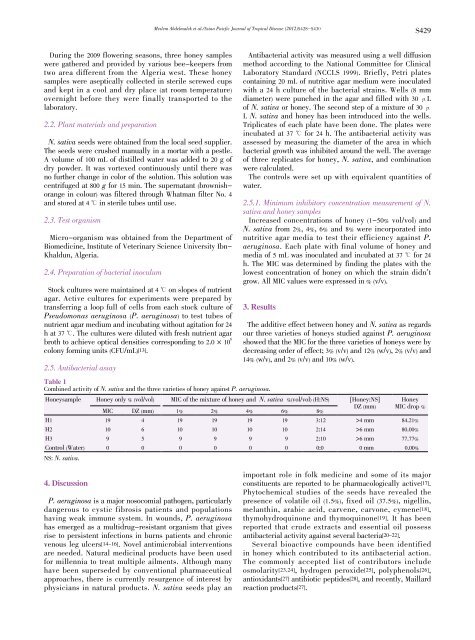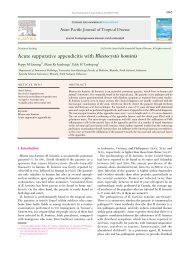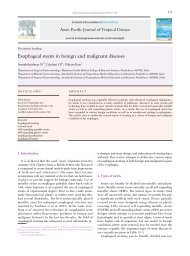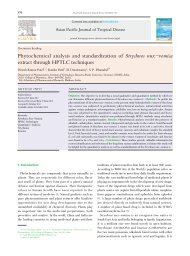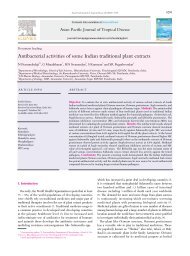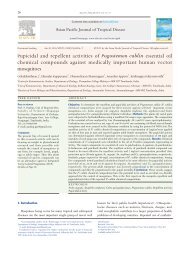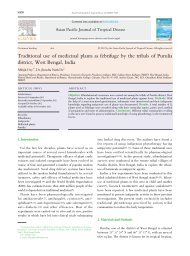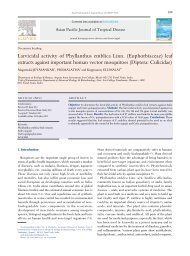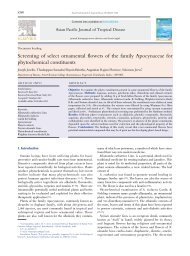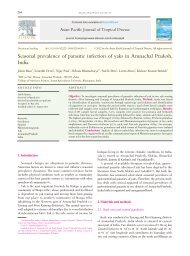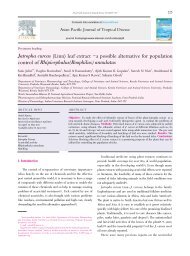Antibacterial activity of honey alone and in combination with Nigella ...
Antibacterial activity of honey alone and in combination with Nigella ...
Antibacterial activity of honey alone and in combination with Nigella ...
You also want an ePaper? Increase the reach of your titles
YUMPU automatically turns print PDFs into web optimized ePapers that Google loves.
Dur<strong>in</strong>g the 2009 flower<strong>in</strong>g seasons, three <strong>honey</strong> samples<br />
were gathered <strong>and</strong> provided by various bee-keepers from<br />
two area different from the Algeria west. These <strong>honey</strong><br />
samples were aseptically collected <strong>in</strong> sterile screwed cups<br />
<strong>and</strong> kept <strong>in</strong> a cool <strong>and</strong> dry place (at room temperature)<br />
overnight before they were f<strong>in</strong>ally transported to the<br />
laboratory.<br />
2.2. Plant materials <strong>and</strong> preparation<br />
N. sativa seeds were obta<strong>in</strong>ed from the local seed supplier.<br />
The seeds were crushed manually <strong>in</strong> a mortar <strong>with</strong> a pestle.<br />
A volume <strong>of</strong> 100 mL <strong>of</strong> distilled water was added to 20 g <strong>of</strong><br />
dry powder. It was vortexed cont<strong>in</strong>uously until there was<br />
no further change <strong>in</strong> color <strong>of</strong> the solution. This solution was<br />
centrifuged at 800 g for 15 m<strong>in</strong>. The supernatant (brownishorange<br />
<strong>in</strong> colour) was filtered through Whatman filter No. 4<br />
<strong>and</strong> stored at 4 曟 <strong>in</strong> sterile tubes until use.<br />
2.3. Test organism<br />
Micro-organism was obta<strong>in</strong>ed from the Department <strong>of</strong><br />
Biomedic<strong>in</strong>e, Institute <strong>of</strong> Veter<strong>in</strong>ary Science University Ibn-<br />
Khaldun, Algeria.<br />
2.4. Preparation <strong>of</strong> bacterial <strong>in</strong>oculum<br />
Stock cultures were ma<strong>in</strong>ta<strong>in</strong>ed at 4 曟 on slopes <strong>of</strong> nutrient<br />
agar. Active cultures for experiments were prepared by<br />
transferr<strong>in</strong>g a loop full <strong>of</strong> cells from each stock culture <strong>of</strong><br />
Pseudomonas aerug<strong>in</strong>osa (P. aerug<strong>in</strong>osa) to test tubes <strong>of</strong><br />
nutrient agar medium <strong>and</strong> <strong>in</strong>cubat<strong>in</strong>g <strong>with</strong>out agitation for 24<br />
h at 37 曟. The cultures were diluted <strong>with</strong> fresh nutrient agar<br />
broth to achieve optical densities correspond<strong>in</strong>g to 2.0 伊 10 6<br />
colony form<strong>in</strong>g units (CFU/mL)[13].<br />
2.5. <strong>Antibacterial</strong> assay<br />
4. Discussion<br />
P. aerug<strong>in</strong>osa is a major nosocomial pathogen, particularly<br />
dangerous to cystic fibrosis patients <strong>and</strong> populations<br />
hav<strong>in</strong>g weak immune system. In wounds, P. aerug<strong>in</strong>osa<br />
has emerged as a multidrug-resistant organism that gives<br />
rise to persistent <strong>in</strong>fections <strong>in</strong> burns patients <strong>and</strong> chronic<br />
venous leg ulcers[14-16]. Novel antimicrobial <strong>in</strong>terventions<br />
are needed. Natural medic<strong>in</strong>al products have been used<br />
for millennia to treat multiple ailments. Although many<br />
have been superseded by conventional pharmaceutical<br />
approaches, there is currently resurgence <strong>of</strong> <strong>in</strong>terest by<br />
physicians <strong>in</strong> natural products. N. sativa seeds play an<br />
Meslem Abdelmalek et al./Asian Paicfic Journal <strong>of</strong> Tropical Disease (2012)S428-S430 S429<br />
<strong>Antibacterial</strong> <strong>activity</strong> was measured us<strong>in</strong>g a well diffusion<br />
method accord<strong>in</strong>g to the National Committee for Cl<strong>in</strong>ical<br />
Laboratory St<strong>and</strong>ard (NCCLS 1999). Briefly, Petri plates<br />
conta<strong>in</strong><strong>in</strong>g 20 mL <strong>of</strong> nutritive agar medium were <strong>in</strong>oculated<br />
<strong>with</strong> a 24 h culture <strong>of</strong> the bacterial stra<strong>in</strong>s. Wells (8 mm<br />
diameter) were punched <strong>in</strong> the agar <strong>and</strong> filled <strong>with</strong> 30 毺L<br />
<strong>of</strong> N. sativa or <strong>honey</strong>. The second step <strong>of</strong> a mixture <strong>of</strong> 30 毺<br />
L N. sativa <strong>and</strong> <strong>honey</strong> has been <strong>in</strong>troduced <strong>in</strong>to the wells.<br />
Triplicates <strong>of</strong> each plate have been done. The plates were<br />
<strong>in</strong>cubated at 37 曟 for 24 h. The antibacterial <strong>activity</strong> was<br />
assessed by measur<strong>in</strong>g the diameter <strong>of</strong> the area <strong>in</strong> which<br />
bacterial growth was <strong>in</strong>hibited around the well. The average<br />
<strong>of</strong> three replicates for <strong>honey</strong>, N. sativa, <strong>and</strong> comb<strong>in</strong>ation<br />
were calculated.<br />
The controls were set up <strong>with</strong> equivalent quantities <strong>of</strong><br />
water.<br />
2.5.1. M<strong>in</strong>imum <strong>in</strong>hibitory concentration measurement <strong>of</strong> N.<br />
sativa <strong>and</strong> <strong>honey</strong> samples<br />
Increased concentrations <strong>of</strong> <strong>honey</strong> (1-50% vol/vol) <strong>and</strong><br />
N. sativa from 2%, 4%, 6% <strong>and</strong> 8% were <strong>in</strong>corporated <strong>in</strong>to<br />
nutritive agar media to test their efficiency aga<strong>in</strong>st P.<br />
aerug<strong>in</strong>osa. Each plate <strong>with</strong> f<strong>in</strong>al volume <strong>of</strong> <strong>honey</strong> <strong>and</strong><br />
media <strong>of</strong> 5 mL was <strong>in</strong>oculated <strong>and</strong> <strong>in</strong>cubated at 37 曟 for 24<br />
h. The MIC was determ<strong>in</strong>ed by f<strong>in</strong>d<strong>in</strong>g the plates <strong>with</strong> the<br />
lowest concentration <strong>of</strong> <strong>honey</strong> on which the stra<strong>in</strong> didn’t<br />
grow. All MIC values were expressed <strong>in</strong> % (v/v).<br />
3. Results<br />
Table 1<br />
Comb<strong>in</strong>ed <strong>activity</strong> <strong>of</strong> N. sativa <strong>and</strong> the three varieties <strong>of</strong> <strong>honey</strong> aga<strong>in</strong>st P. aerug<strong>in</strong>osa.<br />
The additive effect between <strong>honey</strong> <strong>and</strong> N. sativa as regards<br />
our three varieties <strong>of</strong> <strong>honey</strong>s studied aga<strong>in</strong>st P. aerug<strong>in</strong>osa<br />
showed that the MIC for the three varieties <strong>of</strong> <strong>honey</strong>s were by<br />
decreas<strong>in</strong>g order <strong>of</strong> effect; 3% (v/v) <strong>and</strong> 12% (w/v), 2% (v/v) <strong>and</strong><br />
14% (w/v), <strong>and</strong> 2% (v/v) <strong>and</strong> 10% (w/v).<br />
Honeysample Honey only % (vol/vol) MIC <strong>of</strong> the mixture <strong>of</strong> <strong>honey</strong> <strong>and</strong> N. sativa %(vol/vol) (H:NS) [Honey:NS]<br />
DZ (mm)<br />
MIC DZ (mm) 1% 2% 4% 6% 8%<br />
Honey<br />
MIC drop %<br />
H1 19 4 19 19 19 19 3:12 >4 mm 84.21%<br />
H2 10 6 10 10 10 10 2:14 >6 mm 80.00%<br />
H3 9 5 9 9 9 9 2:10 >6 mm 77.77%<br />
Control (Water) 0 0 0 0 0 0 0:0 0 mm 0.00%<br />
NS: N. sativa.<br />
important role <strong>in</strong> folk medic<strong>in</strong>e <strong>and</strong> some <strong>of</strong> its major<br />
constituents are reported to be pharmacologically active[17].<br />
Phytochemical studies <strong>of</strong> the seeds have revealed the<br />
presence <strong>of</strong> volatile oil (1.5%), fixed oil (37.5%), nigell<strong>in</strong>,<br />
melanth<strong>in</strong>, arabic acid, carvene, carvone, cymene[18],<br />
thymohydroqu<strong>in</strong>one <strong>and</strong> thymoqu<strong>in</strong>one[19]. It has been<br />
reported that crude extracts <strong>and</strong> essential oil possess<br />
antibacterial <strong>activity</strong> aga<strong>in</strong>st several bacteria[20-22].<br />
Several bioactive compounds have been identified<br />
<strong>in</strong> <strong>honey</strong> which contributed to its antibacterial action.<br />
The commonly accepted list <strong>of</strong> contributors <strong>in</strong>clude<br />
osmolarity[23,24], hydrogen peroxide[25], polyphenols[26],<br />
antioxidants[27] antibiotic peptides[28], <strong>and</strong> recently, Maillard<br />
reaction products[27].


